RICHARD R. VERNOTZY, P.E., Contributing Editor, Offshore
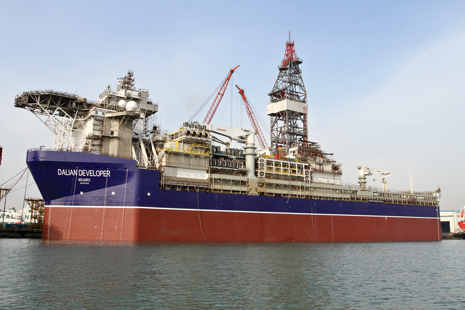 |
| Emblematic of the latest generation of deepwater drilling vessels, the Dalian Developer is billed as the world’s largest drillship. Photo courtesy of Vantage Drilling. |
|
Since the beginning of offshore movable rigs, there have been major changes made with respect to operating water depths and well depth capacities (see also, World Oil, June 2013, p. 21). This article covers some recent rig designs that have come from several design and construction companies. In addition, drilling contractors have made great strides in their safety and training programs. These include state-of-the-art mock-ups in driller training consoles; mechanical roughnecks; and training in drilling riser/BOP/control system handling.
During the last three years, safety, evaluation procedures and well control have been “shored up” quite a bit. Whether mandated by governmental officials, or instituted by the industry, these advancements in the technology that have been implemented on most of the deepwater rigs have improved their safety and efficiency.
NEW RIG DESIGNS
Several recent concepts are covered in this section. They include three drillships, a semisubmersible and a SWATH vessel.
Dalian Developer—a versatile, immense drillship. Dalian Developer is the world’s largest, most versatile drillship and field development vessel. The vessel is classified as a sixth-generation drillship for operation in ultra-deepwater and harsh environments. On behalf of the owner, Dalian Deepwater Developer, Ltd., Odfjell Drilling serves as manager for the vessel. Vantage Drilling was contracted to supervise, on behalf of the owner, the construction management and supervision (engineering, construction, commissioning) of the drillship. Commissioning of Dalian Developer for drilling operations will finish sometime this year.
The new unit has been configured initially as a drilling asset, but it has been designed to accommodate other development activities, such as extended well testing (EWT) and early production, Fig. 1. As a fully functioning drillship, the Dalian Developer can be deployed successfully and utilized fully in normal drilling mode, in virtually any deepwater drilling region, worldwide. The unit has the capability to carry out dual-gradient drilling and underbalanced drilling, and it can drill while performing a well intervention. The vessel also can drill appraisal wells while testing, and drill development wells while producing.
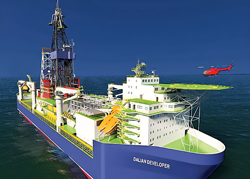 |
| Fig. 1. The Dalian Developer is multi-functional, able to drill as well as conduct extended well testing (EWT) and early production. Photo courtesy of Vantage Drilling. |
|
According to Technip, which has participated in the vessel’s construction, the Dalian Developer is more than double the size of a conventional drillship, at nearly 300 m long and 50 m wide. It has cargo tanks capable of storing up to 1.0 MMbbl of oil. The vessel also has the deck space and deck load capacity (25,000 mt) to install an oil production plant for processing up to 100,000 bopd. The storage capacity and large variable deck load provide potential clients with significant advantages for operations in remote areas, where there is potentially limited support infrastructure.
The industry has been looking for ways to address the risks of deepwater E&P, including oil spills, as well as the industry’s limits in responding to a situation of great magnitude with the right tools and systems. Accordingly, Technip teamed up with Global Well Response Ltd., to transform the Dalian Developer into a drillship that combines both drilling and oil spill containment capabilities. Therefore, the vessel’s production system can be EWT-capable and also act as an oil capture system. In fact, the Dalian Developer is the only mobile drilling unit, worldwide, that is large enough to capture, process and store oil spills in excess of a 60,000-bpd flowrate.
The Dalian Developer’s oil containment equipment is designed primarily as an EWT or early production system, which has been debottlenecked to cater to the oil containment scenario. Therefore, the vessel’s production system is designed for these two primary operating cases:
EWT and early production—30,000 bopd, 30% water cut; heavy oil-capable (<20oAPI); compliant with all export specifications.
Oil containment—100,000 bpd, total fluids, or 100,000 bopd, or 70,000 bopd plus 30,000 bwpd; 200 MMcfgd; compliant with all safety specifications.
The vessel is compatible with existing subsea capture and containment systems, and it could potentially install them, as well.
Among some of the drillship’s other attributes, it has a double-hull structure, built to DNV ICE Class C. There are also identical bow and stern sections for B 90o heading changes, Fig. 2. The vessel has two moonpools, one for drilling, and the second for subsea work and production. Accommodation is also upgradable to 240 personnel. Aker Solutions supplied a complete drilling package for the ship. Wärtsilä also delivered an integrated power and control solution. The package includes a power station, power distribution, integrated control system, electrical propulsion system, AC drives for drilling applications, and pumps for the engine room, ballast and seawater, and fire water.
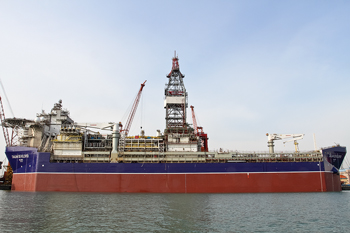 |
| Fig. 2. The Dalian Developer’s identical bow and stern sections are visible in this shipyard photo. Photo courtesy of Vantage Drilling. |
|
The Dalian Developer was constructed at Cosco shipyard in Dalian, China. It has been undergoing commissioning. Odfjell Drilling’s Project Management Team and Operation Preparation Team have supported the owners and the original project team to secure delivery and mobilization of the unit for drilling operations.
Multi-functional semisubmersible readies for first project. The Island Innovator is a sixth-generation semisubmersible that is capable of drilling and conducting well intervention work, Fig. 3. Built for Norwegian shipowners (Marine Accurate Well ASA, aka Maracc), the vessel is managed by Odfjell Drilling for operation, project follow-up and marketing.
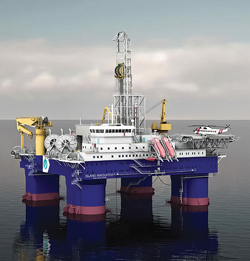 |
| Fig. 3. Designed with the Norwegian offshore sector in mind, the Island Innovator semisubmersible can either drill or conduct well interventions. Drawing courtesy of Marine Accurate Well ASA. |
|
Island Innovator was built at Cosco Shipyard, Qidong, China. The vessel represents a milestone for this shipyard, as it is the first ultra-deepwater semisubmersible to be built in China, via the one-stop solution process (design, construction, commissioning and completion). The vessel’s length is 104.5 m, and the width of the main deck is 81.5 m. Total height of the platform is 103.8 m. The rig’s actual drilling depth limit is 8,000 m.
For well intervention, the Island Innovator can carry four coiled tubing reels (up to 3½-in. coil), and it has on-deck facilities to spool the coiled tubing, Fig. 4. In addition, facilities to carry a CT injector system are installed permanently on the drill floor. The vessel is also able to alternate modus operandi between coiled tubing, wireline and drilling in less than one hour. It is equipped with DP3 dynamic positioning and mooring positioning systems, and there are accommodations for a crew of 120.
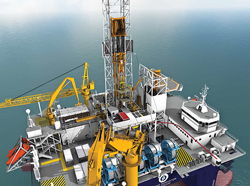 |
| Fig. 4. The Island Innovator’s four coiled tubing reels for well interventions are visible in this concept drawing. Photo courtesy of Marine Accurate Well ASA |
|
By the time it was delivered by Cosco to Odfjell Drilling in second-half 2012, the Island Innovator was already obligated to its first project. In first-half 2012, Maraac and Lundin Norway AS signed a $370-million contract to drill 12 wells on the Norwegian Continental Shelf for the latter firm over a two-year period, beginning this summer. The deal also calls for an option to drill three to four additional wells.
Before taking delivery of the Island Innovator, Odfjell Drilling had mobilized a follow-up team at the yard, to ensure progress and the quality of the remaining work. Nevertheless, the Norwegian-flagged vessel sustained an incident on May 31, 2013, as it was undergoing finalizing and operational preparations at Hanøytangen yard outside Bergen. A leakage occurred through a seawater inlet to a pump room in a pontoon on the rig’s substructure, causing the vessel to tilt. At the time of the incident, 100 people were working onboard the Island Innovator. One person was slightly injured and given medical assistance in the yard. In addition, 63 workers were evacuated from the vessel, as a precaution.
The inlet was plugged, and the rig was stabilized by the ballasting system. Further work was done to secure and normalize the situation on the rig. Subsequently, in mid-June, Norwegian firm Los Elektro was contracted to replace cables and electrical equipment that were damaged, when the rig tilted and took on the water. Los Elektro said that while the scope of work needed was only a rough estimate, it was believed that the repairs would take about 60 days to complete, albeit by running day and night shifts. Value of the work is somewhere between NOK 15 million and NOK 25 million ($2.5 million and $4.1 million). So, the earliest that the Island Innovator can go out to its first wellsite is now approximately mid-August.
Ultra-deepwater design increases deck load, reduces overall dimensions. Fincantieri, one of the largest shipbuilding groups in the world, has unveiled its next generation of drillship. The new “OVERDRILL” design supports an overall maximum drilling depth of 50,000 ft, in water depths of up to 12,000 ft. Aker Solutions supported the development of this design.
Compared to other vessels in the ultra-deepwater category, the OVERDRILL design features an increased variable deck load capacity despite reduced overall dimensions, Fig. 5. This represents an opportunity for drilling contractors to evolve their current fleets with a new class of vessels, featuring a higher level of performance and efficiency at the same time. This design can be adapted further to contractors’ specific requirements and operational procedures.
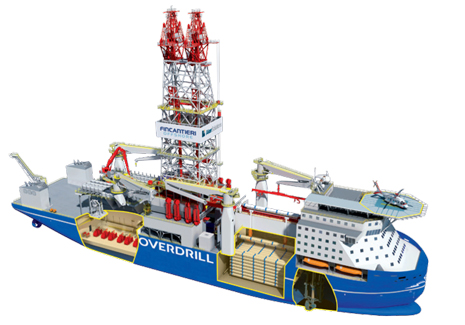 |
| Fig. 5. The OVERDRILL vessel increases deck load while reducing overall dimensions. Photo courtesy of Fincantieri. |
|
The drilling package is designed to meet new requirements related to water depth and drilling length with upgraded capacities, such as increased well pressure (20k) and hookload (1,500 st). Some of the OVERDRILL design’s main characteristics include:
- A length of 208 m, breadth of 40 m, and draft of 17.6 m
- Total installed power generation of 45,600 kW and propulsion consisting of six azimuthal thrusters of 5,500 kW
- Payload is 32,000 tons, almost 30% more than the current drillship average
- Well control equipment is designed for 20,000 psi; there is deck space for two BOPs and seven rams. The BOP overhead crane lifting capacity is 650 mt
- A recessed 150-mt cart skidding system can handle christmas trees up to 13 mt
In addition, there is a dual derrick for enhanced operational capabilities, outfitted with a crown-mounted compensator and an active heave compensation system. The maximum rated static hookloads are 1,650 sh.t on the main rig and 1,300 sh.t. on the auxillary rig.
The riser hold capacity is 12,000 ft, and riser joint lengths are 90 ft. Fincantieri and its partner, Navalimpianti, have developed and patented a fully automated riser handling system. This system allows handling of the joints from inside the hull, up to the riser feeding machine, and vice versa, without any human intervention and without any hanging weight. The crew supervises the entire operation from the riser handling control room. The automation of the whole riser handling system simplifies the hold loading procedure, joint identification, and maintenance management; it can be fully integrated in the ship’s management system.
The vessel’s improved operability can be traced to its optimized hull shape, to the patented bulb-bow design, and to a DP3 dynamic positioning system. Operational endurance is improved by utilizing a large diesel tank capacity of 44,000 bbl, along with freshwater tanks holding 3,750 bbl, and drill water tanks totaling 27,000 bbl.
Jurong Espadon drillship—engineered for the future. As drillships become increasingly favored for offshore deepwater drilling operations over semisubmersibles, there is growing demand in the industry for a more robust, yet efficient, approach to the typical drillship design.
The Jurong Espadon drillship (Fig. 6), jointly developed by Jurong Shipyard and LMG Marine, combines the best engineering practices of both companies to deliver a drillship design engineered to meet the challenges of the next generation of ultra-deepwater projects.
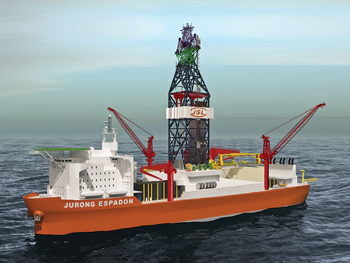 |
| Fig. 6. Engineered to meet the challenges of next-generation deepwater projects, the Jurong Espadon drillship features superior roll motion dampening, for a performance similar to that of semisubmersibles. |
|
Compared to a semisubmersible, a drillship has higher transit speed, a higher variable deckload and larger storage volumes. This makes a drillship suitable for operations in remote deepwater locations. However, due to its monohull ship-shaped design, the drillship is particularly susceptible to roll motions and has considerably poorer motion characteristics, when compared to a semisubmersible. The Jurong Espadon drillship has been developed to overcome this typical drawback. This vessel features a unique, horizontal, bilge box design along the hull, which generates superior roll motion dampening, allowing for better DP performance and crew comfort.
This drillship also features a large 38.4-m x 16.5-m moonpool, allowing for a maximum riser angle of 10o. The large moonpool significantly widens the operational window of the drillship, even in the most challenging environments. The wide moonpool, combined with the horizontal bilge boxes, allows the Jurong Espadon to enjoy the best of both worlds—the larger variable deckload of a drillship, with the motion characteristics of a semisubmersible.
Particular emphasis has been placed in the design of this drillship to integrate, as much as possible, the drilling systems and machinery spaces into the hull. To this end, the riser storage bay, and the mud storage, circulation and treatment systems, are all located beneath the main deck. This approach results in a more efficient utilization of the hull space, lowers the vertical center of gravity, and allows for larger, free deck space.
The vessel’s symmetry at midships, and modularized arrangement of the machinery spaces, allows for a high level of customization. The hull can be equipped with either a dual-activity derrick or one half-derrick. Both 75-ft and 90-ft risers can be accommodated in the riser bay. The riser bay and mud system positions can also be swapped.
The superior motion characteristics , large moonpool, lower center of gravity, integrated machinery spaces in the hull, and flexibility in arrangement, combine to provide a modern, efficient drillship.
Multi-faceted, ship-shaped SWATH vessel. A concept design that was developed some years ago is a “SWATH” vessel that is multi-functional, and whose development is now being pursued by Blue Sea Corporation, Fig. 7. SWATH stands for “Small Waterplane Area Twin Hull,” and the idea was conceived more than two decades ago. SWATH vessels have two pontoon-like hulls that connect to vertical struts that support the central decks and compartments. Unlike pontoon boats, a SWATH’s two hulls ride under the waves. Thus, the twin hulls are like two shallowly submerged submarines. So, like submarines traveling under the surface, they do not feel the effects of the waves rolling above them, which results in a noticeably smooth ride, even in rough conditions.
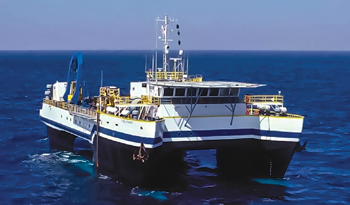 |
| Fig. 7. Similar to this photo, the SWATH vessel proposed by Blue Sea Corporation would perform several operational tasks. |
|
Accordingly, this vessel concept can accommodate several offshore operational tasks
- Completion of a subsea well
- Installation of the subsea “wet” tree
- Installation of a production manifold
- Installation of an Umbilical Termination Assembly
- Installation of plems, plets and flowlines (via J Lay)
The vessel is ship-shaped, can sail at 17 to 20 knots, and is dynamically positioned, once on location.
The vessel will be able to store two or three subsea trees, and have control system testing facilities to enable complete pressure and hydraulic control testing of trees. The hydraulically actuated porch is moved out from within the vessel to the starboard or port side, so that the crane can lift a tree or manifold from a transport vessel onto the porch, to be moved back under the vessel. Fluid capacity, pumps, etc. will enable completing a well that was drilled and cased by a drilling rig.
OCEAN TECHNOLOGY CENTER
The Ocean Technology Center, owned and operated by Diamond Offshore, offers advanced training and full-scale simulation programs. The simulations and training programs are designed to “connect” with people—operators, drillers, managers, trainers and more—all working to deliver the most efficient, safest way to complete a task.
The $9.2-million, 15,000-sq-ft center is located in Houston and was opened earlier this year. The center’s first phase was finished in March, with phase two slated to complete the center’s second floor during this summer. When the center is fully operational, Diamond Offshore expects to train 1,200 students per year.
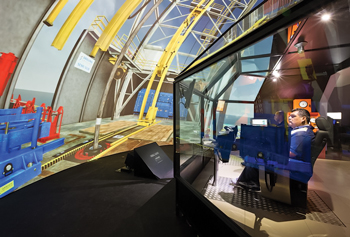 |
| Fig. 8. The Ocean Technology Center operated by Diamond Offshore features three new simulators, with a fourth due for installation, to deliver a more realistic training atmosphere. |
|
Leading-edge electronic drilling/traditional drilling simulation. The new center features multi-million-dollar drilling simulation equipment (Fig. 8) for use in teaching drilling practices and well control. Additionally, the equipment can simultaneously replicate downhole geologic formations, and well pressures and depths. Twelve instructors are assigned to the center, and one more will be added when both phases of construction are complete. Three simulators have been installed, and a fourth, the stability simulator, is expected to move from Diamond Offshore offices to the new center early next year.
Perhaps the star attraction at the center is a 20-ft-high, 40-ft-wide, 180° dome-shaped drilling simulator. It employs seven projectors to reconstruct the entire drill floor. The projectors have laser readers that project a series of dots onto the inside of the dome, and then they bend the images.
In the center, customers’ project leaders can assemble team leads, and their support and service personnel, to work through a planned well with strategic procedures to address the specific project. The center provides a designated space, along with technology and expertise, to help customers and employees plan shared projects together.
Spud meetings. The process of beginning to drill a well, or spud, is an opportunity to review the dynamics and critical components of the well. Diamond Offshore says that its customers and teams from operations, management and training meet at The Ocean Technology Center training facility, to review their approach to the well and discuss any challenges. The training team becomes a sounding board and consultant group to help assure the most efficient, safe operations on the rig. 
|











